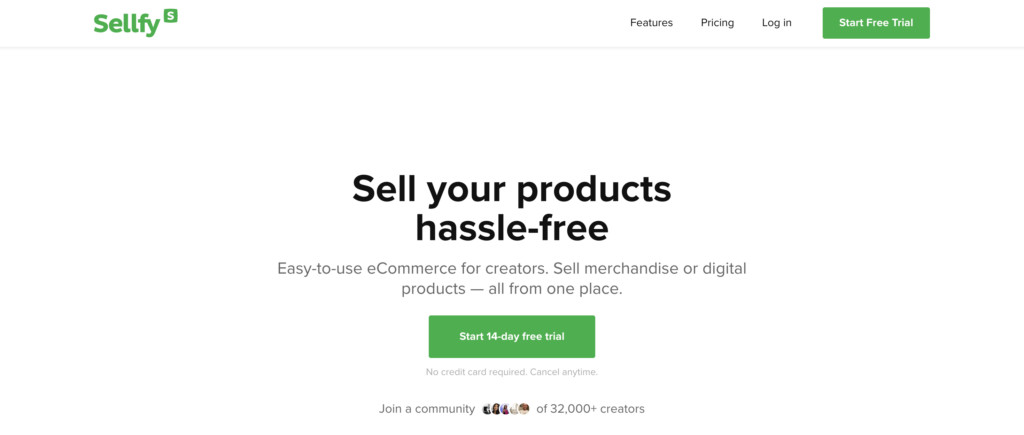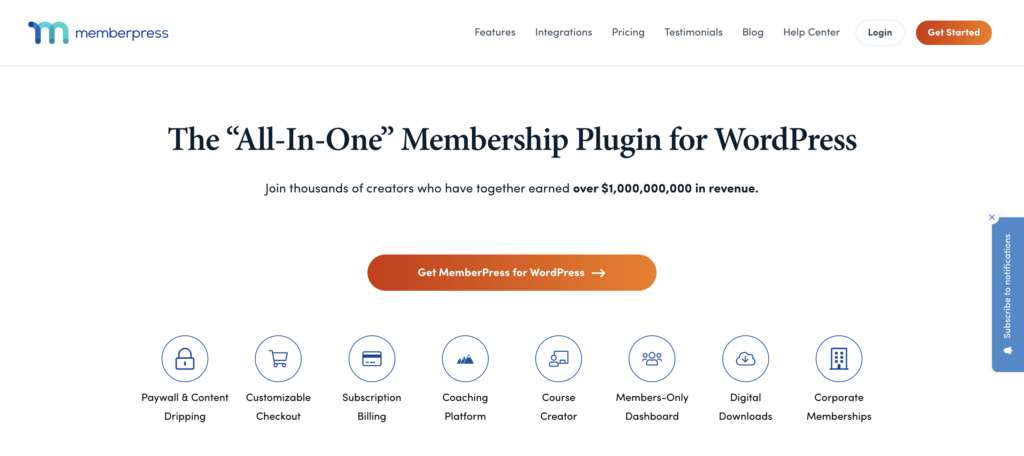WORDPRESS
10 Best Gumroad Alternatives To Scale Your eCommerce Business in 2023

Looking for the best Gumroad alternatives?
Gumroad simplifies eCommerce with easy setup and zero subscription fees. Yet, its percentage system might not fit everyone’s bill.
Many users find Gumroad lacking, especially if you’re after more customization, varied payment options, or advanced marketing tools.
Luckily, we’ve handpicked the 10 best Gumroad alternatives with unique feature sets and options to help you scale your eCommerce business.
10 Best Gumroad Alternatives For Online Entrepreneurs
Gumroad has been a favorite amongst eCommerce newbies for one reason—their flat 10% per-sale fee.
While paying no upfront cost might sound appealing when you’re just starting off, that 10% transaction fee (plus card charges) can quickly start eating into your profits. Moreover, Gumroad lacks some essential features, such as upselling and instant payouts, which can hinder growth.
Fortunately, many alternatives to Gumroad provide better, if not equal, options without slashing 10% off everything you sell. In this list, you’ll find their key features, pricing structure, and a detailed overview.
Let’s dive in:
1. Shopify: Best Overall

Shopify is the most popular platform for selling all kinds of stuff online—for good reason. It’s easy for non-tech-savvy people, supports various payment methods, and offers various marketing and delivery services. This means you can build and grow your small business into a multi-million dollar brand right from Shopify.
One of the best things about this platform is how fast and attractive the store pages look on most devices. Its drag-and-drop builder lets you design a stunning website within minutes. You can integrate buttons, forms, or image sliders with a few clicks.
Creators also love the Shopify mobile app. It lets you monitor your orders, payments, and delivery systems no matter where you go. Whether you run an online store, a retail shop, or both, Shopify supports various payment gateways and even has a POS system to track your transactions in one place.
The only downside is paying for extra features like third-party apps and fancy themes. You can test the platform for 3 months by paying just $1 per month until the free trial runs out. But for those with the budget, Shopify is a solid choice to kickstart your online selling journey.
Key Features
- Fully-hosted all-in-one eCommerce platform
- Multi-currency support with built-in gateway and POS system
- No bandwidth or product limits
- Creator-focused tools and built-in marketing suite
Price
Shopify offers a 3 month free trial at just $1 per month. After that, you can choose one of the following paid plans:
- Basic: $25 per month
- Professional: $65 per month
- Advanced: $399 per month
You can get a 25% discount by purchasing an annual subscription.
To get a more in-depth overview of Shopify and its features, check out our Shopify Review: Worthy Of Its Reputation As The Leading Ecommerce Platform?
2. Sellfy: Most Marketing Options


Sellfy is a fully hosted eCommerce platform, the second closest alternative to Gumroad. Whether you’re selling digital items, physical goods, subscriptions, or print-on-demand products, Sellfy has something in store for you.
Setting up a store on Sellfy takes only a couple of minutes. You can connect it to an existing website or build a brand-new site from scratch. With Sellfy’s store customizer tool, you can add a logo, change color palettes, and even add language selectors to target international buyers.
If you’re into selling custom-printed products, you won’t need any external solutions or pricey integrations while using Sellfy. The platform will handle everything from fulfilling orders to printing and shipping worldwide. Plus, you’ll only pay for fulfillment after making a sale, so you don’t need to worry about upfront costs or unsold stock.
One place where Sellfy really shines is in marketing. You can effortlessly add tracking pixels, create email marketing campaigns, generate various discount codes, and promote upsells within the platform. Each one of these features can dramatically increase revenues and repeat purchases for businesses.
Another big plus for Sellfy is that it doesn’t take a cut of your income. Instead, you pay a minimal monthly subscription fee to utilize their range of tools and grow your venture.
Key features
- Sell physical + digital + POD products and subscriptions
- Tracking pixels, email campaigns, coupons, and other marketing tools
- Customizable storefront with multilingual support
- Supports PayPal, Stripe, and other popular payment channels
Pricing
Sellfy does not have a free plan. Premium plans start at:
- Starter: $29 per month
- Business: $79 per month
- Premium: $159 per month
The company doesn’t charges a transaction fee on any of its plan.
3. WooCommerce: Top Pick For WordPress Stores


WooCommerce is a solid option for businesses running an online store on WordPress. It’s open-source and completely free—you’ll only have to pay for hosting and domain. With WooCommerce, you can sell anything from physical products to memberships, digital downloads, and even affiliate products.
Being an open-source platform, WooCommerce pairs well with a variety of themes. While designing a store with WooCommerce takes some expertise, its flexibility is also miles ahead of other platforms. Alternatively, you can use drag-and-drop builders like Elementor to make customization convenient.
Compared to Gumroad, WooCommerce offers a boatload of plugins and integrations. You can install them from WordPress’s library and enable features like upselling, email marketing, SEO, pixel integration, discount codes, and more. There are also plugins to connect WooCommerce with payment gateways like Stripe, PayPal, and AliPay.
Even though WooCommerce can be overwhelming for beginners, it’s an outstanding platform for businesses prioritizing scalability and extra options.
Key features
- Huge library of add-ons, themes, and extensions
- User-friendly mobile application for tracking orders
- Highly customizable storefront and hundreds of themes
- Detailed reporting on revenues and customer behavior
Price
WooCommerce is a free plugin. However, you will need to pay for any extensions and the domain + hosting.
4. BigCommerce: Great For Large Businesses


BigCommerce is a superb alternative to Gumroad for B2B and B2C companies. With advanced features like multiple storefronts, cross-channel selling, and multi-currency support, BigCommerce is a solid fit for larger corporations and SaaS ventures operating internationally.
At the basics, the platform features a drag-and-drop page editor that simplifies site customization. You can also edit individual elements with HTML, CSS, or Javascript. Speed and security are key with BigCommerce. The platform ensures quick site loading and a 99.99% uptime, so you don’t miss any sales.
Inventory management is also smoothly managed by BigCommerce. The system efficiently tracks stock across various channels and compiles this data in a single dashboard for easy access.
If you’re operating across continents, BigCommerce accepts payment in 99+ currencies and supports front-end translation through third-party apps. B2B businesses can also create customer categories to display bulk + individual pricing, shipping cost, and quotations according to specific countries.
With extra goodies like multiple storefronts, social eCommerce, and eBay/Amazon integration, BigCommerce is one of the best Gumroad alternatives for established or multinational organizations.
Key features
- Strong list of payment gateways in multiple currencies
- Tons of customization flexibility with CSS and HTML
- Wide range of B2B-specific features
- Seamless integration with eBay, Amazon, and more
Price
BigCommerce’s plans start at the following prices:
- Standard: $39 per month
- Plus: $105 per month
- Pro: $399 per month
With an annual subscription, you get 25% off on the final price. BigCommerce also doesn’t have any transaction fees.
5. Payhip: Most User-Friendly Platform


Payhip is an exceptional Gumroad alternative for online coaches and creators. Recognized for its simple interface and uncomplicated checkout process, the platform has many options, especially if you’re a mentor or online tutor.
A few key features of Payhip include building online communities, conducting 1:1 sessions via Zoom, selling digital downloads, and hosting extensive video courses via recurring payments through Stripe or PayPal. You can also sell various physical products and manage inventories, fulfillments, and promotions using built-in tools.
New business owners can easily integrate Payhip into their existing website or blog. Otherwise, you can build a Payhip storefront from scratch and add image galleries, color schemes, or blog sections as you like. This flexibility and support for multiple languages is a major win for newcomers looking to sell to local or international customers.
The standout advantage of Payhip is its user-friendly nature. It’s designed for beginners in eCommerce and only requires a few minutes to get up and running. However, this simplicity does have its trade-offs, particularly in marketing features. Beyond upsells and coupon codes, don’t expect a wide array of marketing tools.
Payhip offers a free plan with a fixed 5% transaction fee and additional payment processing costs, which is still quite lower than Gumroad’s fees.
Key features
- Best for coaches and digital entrepreneurs
- Supports multi-tier pricing for subscribers
- Faster payouts with PayPal and Stripe support
- Affiliate, upsells, referrals, and other marketing tools
Price
Payhip has a variety of paid plans that charge less transaction fee as you upgrade:
- Free: $0 + 5% transaction fee
- Plus: $29 + 2% transaction fee
- Pro: $99 + 0% transaction fee
6. Pattern by Etsy


Etsy has been an online haven for hobbyists and artists for years. The platform has close to 100 million active buyers, and with Pattern by Etsy, you can build your own customized storefront to sell your digital and physical products.
Pattern lets you build a stunning online store and sync your items list from Etsy within minutes. You can host your store on an existing domain or buy one from Pattern’s dashboard to build a unique brand. The platform provides pre-made templates with plenty of room for customization.
Both your Pattern-powered website and Etsy store can be centrally managed using their Shop Manager. Your stock, orders, and deliveries will be accessible on a single dashboard for convenient tracking. Etsy also takes security seriously, which is why SSL and payment protection are built into Pattern.
You also get a range of basic marketing tools like social sharing, pixel tracking, and integration with MailChimp to drive traffic to your online store. Judging by their flat $15 monthly subscription fee, Pattern is a no-brainer for enthusiastic Etsy sellers looking to expand their horizons.
Key features
- Instant item syncing with existing Etsy store
- Customizable storefront with ready-made templates
- Shop Manager tracks Pattern + Etsy orders in one place
- Budget-friendly and variety of marketing tools
Price
Etsy charges a standard $0.20 listing fee for one SKU and 6.5% transaction fee on every sale.
You can try Pattern by Etsy for 30 days free, after which you will be charged $15 per month. Purchasing a domain from Pattern comes with extra charges.
7. MemberPress


MemberPress is a killer Gumroad alternative for people in the coaching industry that caters to ‘members’ instead of one-time customers.
Building a beautiful, user-centric website with MemberPress takes less than a day—thanks to their incredible drag-and-drop ReadyLaunch page builder. MemberPress also comes with a learning management system (LMS) add-on that lets you create a learning path with step-by-step instructions for students. CoachKit makes this process even easier with tools like course creators and meeting schedulers.
A highlight feature of MemberPress is automated drip content. This system requires users to complete certain tasks to access advanced lessons, which keeps them engaged and increases the likelihood of continued subscription payments.
The plugin also seamlessly integrates with WordPress, has a coupon feature, lets you build a community of subscribers, and supports a variety of payment gateways, including Apple Pay and Google Wallet.
Key features
- LMS and Drip Content for creating learning paths
- Support for multiple community forum plugins
- Seamless integration with WordPress, Apple Pay, and Google Wallet
- Connects easily with MailChimp and Zapier
Price
MemberPress’s has a variety of annual plans that start at:
- Basic: $359 per year
- Plus: $599 per year
- Pro: $799 per year
- Elite: $999 per year
All the plans have a 0% transaction fee. The platform doesn’t offers monthly subscription plans.
8. Podia


Podia is another all-in-one, user-friendly eCommerce platform for those in the digital niche.
On their website, you can find that Podia is tailor-made for people, employing one of the five business models: online courses, digital downloads, webinars, communities, and coaching programs.
Within these models, you will get multiple built-in tools to engage with your members and scale your startup. A few basic ones include automated drip content, video hosting, upsells, coupons, and moderation controls for forums.
Designing a website is also super-easy with Podia. You can take advantage of their drag-and-drop builder to create landing pages. Or, you can use the same builder to craft beautiful email templates with full control over colors, fonts, images, and much more.
Unfortunately, there’s one big downside to Podia—no option to sell physical goods. The platform is solely made for virtual items, so you won’t find any options for tracking shipments or inventories. However, if you don’t plan to shift towards selling merchandise, Podia is a decent Gumroad alternative for digital entrepreneurs.
Key features
- Ability to host pre-recorded and real-time webinars
- Unlimited bandwidth with video and file hosting
- Live chat and messaging tools
- Drag-and-drop builder for storefront and emails
Price
Podia has a Free plan with an 8% transaction fees. Mover plan starts at $39/month and Shaker starts at $89/month.
Both paid plans have a 0% transaction fee. You can get 17% off on yearly plans.
9. SendOwl


SendOwl is an easy-to-sell eCommerce platform with a unique twist.
Unlike Gumroad, SendOwl acts as a middleman between you and your audience. When you upload your podcast, online course, or ebook, it automatically generates a link. You can attach this link as a ‘Buy Now’ button on your website or social media. When someone clicks on it, they’re sent to your SendOwl page to finish the purchase.
SendOwl also fits well with influencers, YouTubers, and artists, especially if you have a decent fan base. You can effortlessly monetize website traffic, utilize Shopify integrations, or sell directly through SendOwl’s API.
Another major win for SendOwl users is its range of marketing tools. You can add one-click upsells, gift purchases, and send cart abandonment emails. SendOwl also follows multiple security protocols to protect your digital content, such as time-restricted download links, access management, fraud filters, and two-factor authentication.
It’s worth noting that SendOwl does not offer the ability to build personalized storefronts. But if you don’t want to build a separate landing page anyway, SendOwl is the perfect tool for digital creators who want to offload tasks like payment processing, checkout, and file delivery.
Key features
- Simple ‘one-link’ system for quick selling
- Intuitive and responsive checkout
- Various security protocols and enhanced protection
- Wide range of marketing features and toolkits
Price
SendOwl has a range of paid plans with varying transaction fees:
- Starter: $9/month + 5% transaction fee (free for 3 months)
- Growth: $15/month + $0.33 fixed fee per order
- Pro: $39/month + $0.17 fixed fee per order
10. Patreon


Patreon has been a regular amongst YouTubers, photographers, and influencers for years. If you have a decent fan following and want to cash in your hard work, Patreon offers a centralized platform to engage with followers, share new stuff, and sell various digital items in one place.
Creators can build a customized profile on Patreon where members can receive exclusive updates—something you can also limit by creating multi-tier membership plans. You can also interact with fans through posts, a built-in polling system, or even personal DMs to build a deeper connection they appreciate.
As for eCommerce, Patreon lets you upload and sell digital products on a dedicated shop tab. This process becomes even easier with support for global currencies, payment gateways like PayPal, and a fluid checkout experience. If you want to amp up your sales, Patreon offers cross-promotion, in-depth analytics, and integration with MailChimp, WordPress, and Discord.
Like Gumroad, Patreon operates on a percentage-based fee—the more you earn, the more you pay. Rates can reach up to 12% with their Premium plan. This model means lower costs when starting out but higher fees as your earnings increase.
Key features
- Multi-tier pricing option for premium members
- Intuitive mobile app and direct messaging
- In-depth analytics dashboard with various metrics
- Attractive and user-friendly community and feed manager
Price
Pateron is completely free for all creators. However, they keep 8% of your earnings on Pro plan and 12% of your earnings on Premium plan.
Conclusion
That’s it for this article. We’ve scoped out the 10 best Gumroad alternatives for all kinds of business owners, each bringing something different. Consider how fees, support, and payout timing fit your creative process.
Gumroad skips the monthly fee but takes a slice of your sales. Other platforms might offer sweeter deals, faster access to your earnings, and more helpful support. Pick the one that aligns with your creative ambitions, ensuring you have the tools and backup to skyrocket your online venture.
If you want to start an eCommerce business on a budget, check out our guide on How To Make Money With Ecommerce: Get Started For $200 Or Less!
Or, if you’re looking for lucrative gaps in the dropshipping world, read our list of Best Dropshipping Business Ideas: 9+ Niches That Actually Work!
















